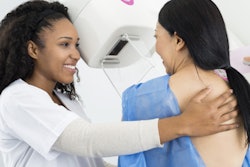
A quarter of socioeconomically disadvantaged patients don't receive the follow-up imaging recommended for them, a study published October 26 in the American Journal of Roentgenology has found.
This patient group faces a variety of factors that can prevent them from getting follow-up imaging, including living in a poorer neighborhood, care setting (inpatient or emergency department), or even the surgical referrer's specialty, noted a group led by Dr. Neena Kapoor from Brigham and Women's Hospital in Boston. Concerted effort is needed to overcome these blocks.
"These factors could be targeted in efforts to ensure timely completion of clinically necessary follow-up testing," the investigators wrote.
Previous research suggests that over one-third of recommendations by radiologists for follow-up imaging are not acted on. Reasons for this include gaps in communication between patients and their doctors and tracking whether patients are complying with follow-up recommendations. The situation is especially problematic for patients with adverse social determinants of health and can lead to health disparities when it comes to completing recommended follow-up imaging.
To further explore the issue, Kapoor and colleagues conducted a study to test an automated communication and tracking tool that identified factors related to patients, referrers, and imaging that were associated with a lack of radiologist-recommended follow-up imaging.
The tool was integrated into the PACS and electronic health record at Brigham and Women's. It prompted referrers to record whether they deemed follow-up imaging recommendations to be clinically necessary and whether this follow-up imaging had been performed. If the recommended exam was not done within a month, the tool cued a safety net team to contact the patient and referrer.
The study included data from 5,856 follow-up imaging recommendations made between 2019 and 2021. Of these, the referrer agreed with 4,881 recommendations in 4,599 patients.
Although Kapoor's group found that follow-up imaging was done in 74.8% of the recommendations, it also found that the remaining quarter of recommendations that were not fulfilled tended to have specific predictors.
| Predictors of lower likelihood of completing follow-up imaging | |
| Predictor | Odds ratio (with 1 as reference) |
| Referrer surgical specialty | 0.7 |
| Living in a socioeconomically disadvantaged neighborhood based on area deprivation index | 0.67 |
| Inpatient care setting | 0.25 |
| Emergency department care setting | 0.09 |
The team also reported, however, that patient age, race and ethnicity, primary language, and insurance status were not associated with patients not following through with additional imaging.
The study results underscore further work that needs to be done to ensure vulnerable patients get the imaging they need, according to the authors.
"Quality improvement initiatives should target the identified factors to address disparities in receipt of clinically necessary follow-up testing and thereby reduce missed and delayed diagnoses," they concluded.




















